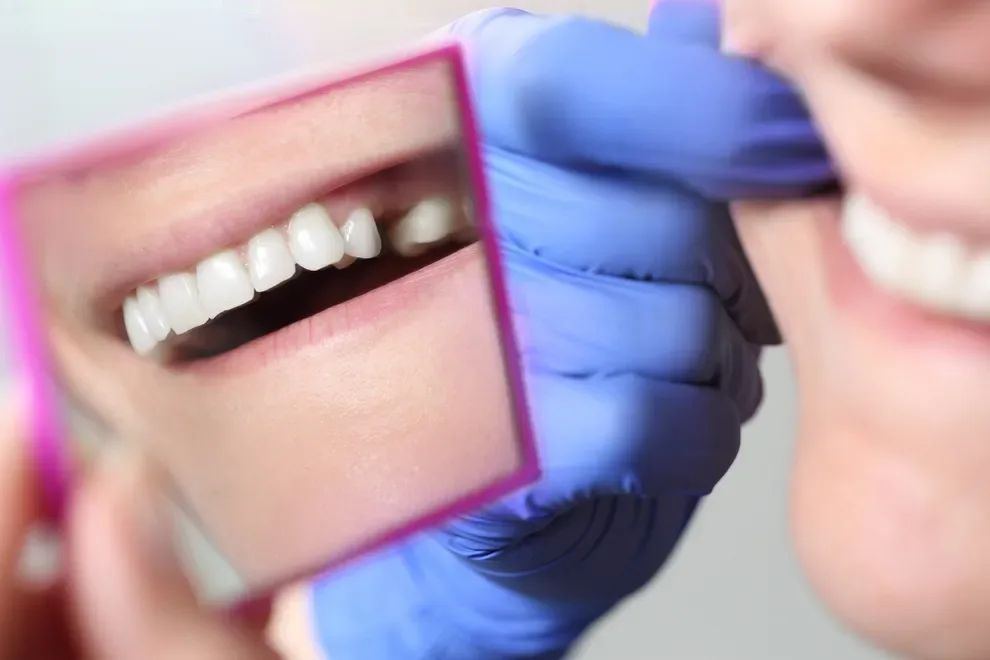Dental Options for Replacing Missing Teeth

Table of Contents
- Bridges
- Dental Implants
- Partial Dentures
When it comes to oral health, there are few things that scare people more than losing a tooth. Not only is a missing tooth often noticeable and uncomfortable, but it can also lead to more oral health problems and create difficulties in eating and in everyday life.
In order to avoid these issues and maintain the structure and integrity of your jaw and bite, it’s important to replace a missing tooth as quickly as possible. Depending on the causes of your missing tooth and your situation, you’ll likely choose from three options to replace your missing tooth: a fixed bridge, a dental implant, or partial dentures.
Bridges
Dental bridges use crowns. Crowns are caps that are placed on top of dental implants or damaged teeth in order to protect, cover, and provide shape to teeth or implants. They can be made of porcelain, ceramics, metal, or resin, and they are generally low maintenance.
In dentistry, bridges are formed by fusing artificial teeth to a metal frame that is supported by cement bonds that are attached to crowns on either healthy, natural teeth or dental implants.
Cost of replacing missing teeth with a bridge
The price of crowns is a major factor when considering the cost of a dental bridge.
Depending on a number of factors — including the materials used, the complexity of the procedure, and your choice of dentist — a fixed dental bridge will range from $1,500 to upward of $5,000. Bridges that require dental implants for support are the most expensive.
Pros of replacing missing teeth with a bridge
If fitted properly, bridges should have a very comfortable and natural feeling.
Bridges are generally less expensive than dental implants.
The process of getting a dental bridge is less invasive than dental implant surgery and requires fewer procedures and dentist visits.
If your bridge is made with ceramic or porcelain materials, they will look natural and not noticeable.
Your dental insurance may cover some of the costs of a dental bridge, depending on your plan and provider.
Cons of replacing missing teeth with a bridge
In order to get a bridge, the surrounding teeth will have to be treated with crowns, meaning they will be filed down in order to fit properly. Their enamel will be damaged, even if they are healthy teeth. If you decide to get dental implants later, those teeth will still be damaged from enamel removal.
Bridges usually need to be replaced every 5 to 10 years.
If fitted incorrectly, bridges may feel less natural than dental implants.
Bridges require more maintenance than dental implants, and there is a higher risk of tooth decay.
Not everyone is a candidate for bridges. People with crowded teeth may not have space for bridgework, and people with weakened teeth roots or certain jaw conditions may be unsuitable for bridges.
Dental Implants
Dental implants are titanium metal screw posts that are placed in a person’s mouth to replace a missing tooth. Implant fixtures serve to replace a problem tooth’s root and hold artificial teeth in place. They are used to secure bridges, crowns, partial dentures, and full dentures.
The process of getting an implant may require a lot of time and multiple visits to your dentist. After an initial scan of your mouth, your dentist will decide if your jaw and gums are strong enough to receive an implant. In order to provide the sturdy support it’s designed to provide, the implant needs to be well-supported by the rest of your mouth.
If your mouth or jaw is not strong enough, your dentist may need to perform a dental bone graft to provide the structure needed to hold the implant. This can add a considerable amount of time to the implant process, as the bone will have to heal for three to nine months after a bone graft procedure before an implant procedure can be performed.
Once it’s been confirmed that your mouth and jaw can support the implant, the implant post is fitted into your gum with a small cap. For a few weeks, your jawbone will grow around the post. This provides strength around the structure.
Once the implant is secure, the cap is removed and replaced with a titanium screw. Your dentist then puts on your porcelain crown (color-matched to the rest of your teeth), either cementing or screwing it on to the titanium nail.
Cost of replacing missing teeth with dental implants
The cost of dental implants varies greatly depending on several factors, such as the type of sedation used and whether bone grafting is needed. Generally, the cost of replacing a single missing tooth with a dental implant will run from $3,100 to $5,800.
Pros of replacing missing teeth with dental implants
Many dental implants will last for your lifetime and won’t require replacement.
Unlike bridges, dental implants don’t require the support of other teeth and therefore don’t require the surrounding teeth to be altered or weakened.
Dental implants feel very natural.
Dental implants look like your normal teeth.
Dental implants provide strength and structure to your bite and keep teeth from shifting out of place.
Dental implants don’t require additional maintenance.
Cons of replacing missing teeth with dental implants
The process of getting dental implants is more involved (possibly including bone grafting and multiple dentist visits) and requires at least one surgery.
Dental implants may be more expensive than bridges or dentures.
Insurance plans may be more likely to cover the costs of bridgework rather than dental implants. Talk to your insurance provider to confirm.
Not everyone is a candidate for dental implants, including people with certain types of diabetes, those who have undergone certain radiation treatments, and smokers.
While 95 percent of dental implants are successful, there is still a 5 percent chance of your dental implant being rejected by the body and having to be removed.
Partial Dentures
Partial dentures are removable replacement teeth, designed to fit between your natural teeth. Crowns can also be used to hold the dentures in place if your natural teeth aren’t strong enough to serve as an anchor.
With partial dentures, artificial teeth are on a natural, gum-colored base, often attached to a metal base. That metal base fits securely in your mouth, between teeth or crowns. Partial dentures are removable. For people missing all of their teeth, full dentures are available.
Cost of replacing teeth with partial dentures
The cost of dentures will depend on a number of factors, including the materials used, the dentist you use, and whether or not you’ll require crown work. The average cost for partial dentures is around $1,400 to $1,800.
Pros of replacing teeth with partial denture
Partial dentures are the most affordable tooth replacement option and frequently covered by dental insurance.
The process of getting dentures is noninvasive and doesn’t require surgery.
Because they are removable, dentures can offer an easier temporary solution to a missing tooth if you are still deciding on another option.
If you are limited in options, choosing partial dentures is better than not replacing a missing tooth at all, as they will help with eating, speech, and jaw support.
Cons of replacing teeth with partial dentures
Dentures feel less natural than implants or bridges and can take time to get used to.
Dentures can slip out while you’re eating or talking.
Dentures require additional maintenance as bacteria and particles can build between artificial teeth. In addition to daily dental hygiene, dentures need to be cleaned and sterilized as well.
Most dentures will loosen after a few years use. If they aren’t replaced, the loosened fit can cause discomfort and mouth sores.
Certain foods can cause problems for denture-wearers and may need to be avoided. These include sticky candy, popcorn, seeded crackers, and some chewy meats.
